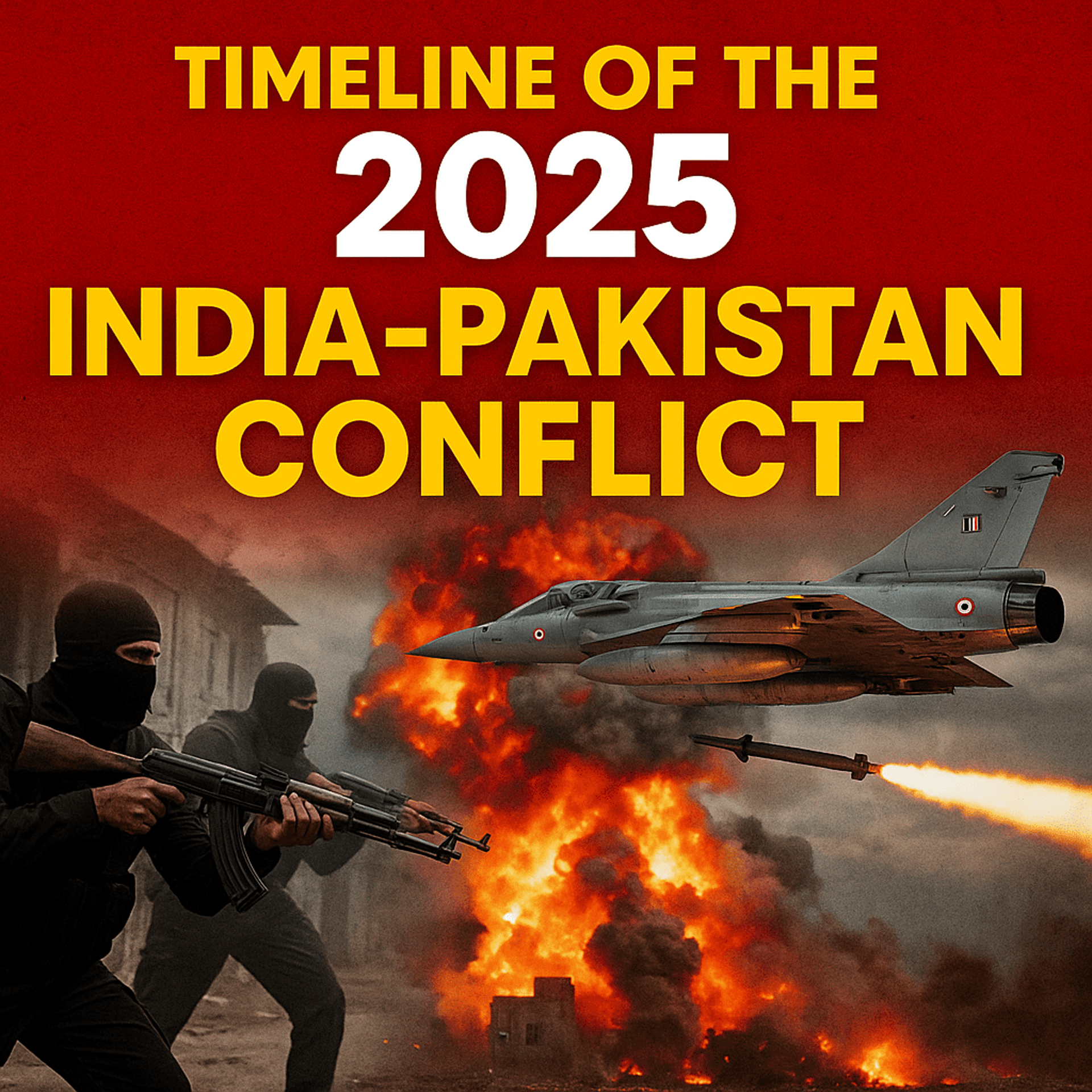
2025 India-Pakistan Conflict Timeline: Kashmir to Missile Strikes
Explore the 2025 India-Pakistan conflict timeline—from the Kashmir massacre on April 23 to cross-border missile strikes—detailing key events, casualties, and global reactions.
NEWSFEATUREDEDUCATION


2025 India-Pakistan Conflict Timeline: From Kashmir Massacre to Missile Strikes
The 2025 India-Pakistan conflict timeline unfolds a harrowing saga of terror, tit-for-tat military moves, and civilian suffering. Rooted in the decades-long Kashmir dispute, this latest flare-up began on April 23, 2025, with a brutal massacre of tourists in Pahalgam and quickly escalated into cross-border missile strikes. In this comprehensive timeline, we trace every major development—diplomatic expulsions, LoC skirmishes, Operation Sindoor, Pakistan’s retaliation, and the mounting humanitarian toll—to offer readers a clear, chronological account of one of South Asia’s most dangerous escalations.
April 23, 2025: The Spark – Kashmir Massacre
Event Gunmen ambush tourists at Baisaran Valley, killing 26 (mostly non-Muslims) and injuring 20+.
Context The deadliest civilian attack in Kashmir since 2000, reigniting communal tensions.
Aftermath:
India accuses Pakistan-backed groups (JeM, LeT).
Diplomatic measures: expulsion of Pakistani diplomats, visa suspensions, border closures, and India’s withdrawal from the Indus Waters Treaty.
Pakistan denies involvement, imposes trade restrictions, closes its airspace, and suspends the Shimla Agreement.
SEO note: Mentioning “Kashmir massacre 2025” and “India Pakistan escalation” here supports LSI relevance.
April 24 – May 6, 2025: Escalation Along the Line of Control
Clashes: Daily artillery shelling and cross-border firing along the LoC.
Casualties: Unconfirmed military losses; civilian displacement in border villages.
Key developments:
Schools in frontier districts shut.
Thousands of families evacuate to interior shelters.
International appeals for restraint intensify.
May 7, 2025: India’s Operation Sindoor
Operation Sindoor marks India’s first use of precision air and missile strikes in this conflict.
Targets: Nine alleged militant camps belonging to Jaish-e-Mohammed and Lashkar-e-Taiba.
Indian account: 100 militants killed; operation framed as preemptive counter-terrorism.
Pakistani account: Civilian areas hit—mosques in Muzaffarabad, Bagh and towns like Ahmedpur Sharqia suffer; 31 civilian deaths, 57 injuries.
Air battle claims:
Pakistan: Five Indian jets downed (including three Rafales).
India: Denies losses; French confirmation of one Rafale downed.
Implications:
Satellite imagery shows widespread damage in Muridke.
Global alarm over nuclear-armed neighbors exchanging strikes.
May 8, 2025: Pakistan’s Retaliation
Missile and drone strikes aimed at Indian bases near Amritsar; intercepted by India’s S-400 system.
Defense success: India reports neutralizing all incoming projectiles; Pakistan claims downing 25 Indian drones.
LoC shelling:
15 Indian civilian deaths, including two children, and 43 injuries in Uri and Poonch.
Debris of downed aircraft in Pampore raises further questions.
May 9, 2025: A Tense Stalemate
Status at 11:34 AM IST: No new major strikes but high military alert persists.
Airspace closures:
India: 27 airports shut; 430+ flight cancellations affecting Air India, IndiGo, SpiceJet.
International rerouting by Lufthansa, KLM, Singapore Airlines.
Pakistan: Suspends flights at Karachi, Lahore, Sialkot.
Civilian measures:
Border blackout drills.
Panic-buying in Punjab, India.
Relocation advisories for LoC residents.
The Human Toll
Civilian casualties: India: 15 killed, 43 injured. Pakistan: 31 killed, 57 injured.
Military losses:
India: 1 confirmed Rafale down; 2 soldiers killed.
Pakistan: Claims 5 jets and 25 drones destroyed.
Economic impact: Collapse of Kashmir tourism at peak season; local hotels and shops shuttered.
Psychological scars: Videos of grieving families in Muzaffarabad; images of tearful children in Uri circulate globally.
International and Domestic Reactions
Global powers:
USA: Offers mediation; President Trump pledges talks.
UN: Secretary-General Guterres warns of “catastrophe between nuclear states.”
China: Condemns India’s strikes as “regrettable.”
Regional voices:
Malala Yousafzai: Appeals for dialogue and mercy.
Pakistani actors and civil-society coalitions call for peace talks.
Indian protests: Mixed reactions, from rallies celebrating Operation Sindoor to peace marches in Delhi.
What’s Next?
Risk factors: Nuclear deterrence, internal political pressures, militant reprisals.
Diplomatic efforts: Back-channel talks; US envoy expected in New Delhi by May 11, 2025.
Humanitarian action:
Calls for cross-LoC ceasefire for medical evacuations.
UN proposals for an international observer mission.
Conclusion
The 2025 India-Pakistan conflict timeline underscores how quickly a single act of terror can unleash a cascade of military reprisals between two nuclear-armed nations. As both sides hold fast to their claims of moral and legal justification, the world watches anxiously, hoping that cooler heads will prevail before a limited exchange becomes a full-scale war.

